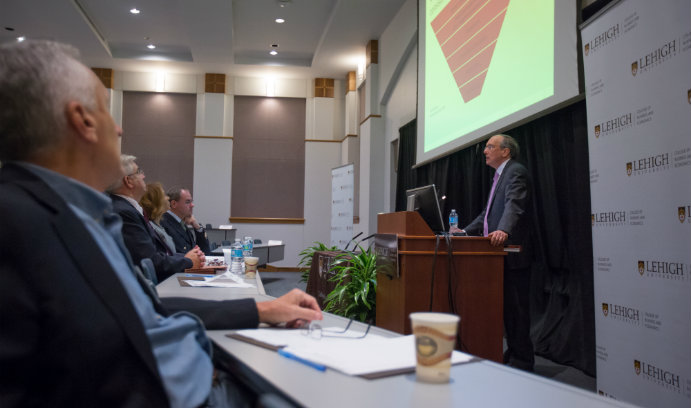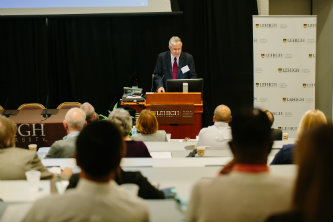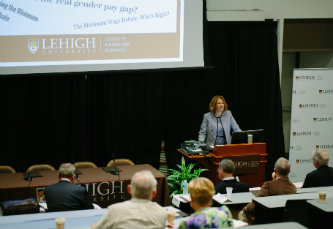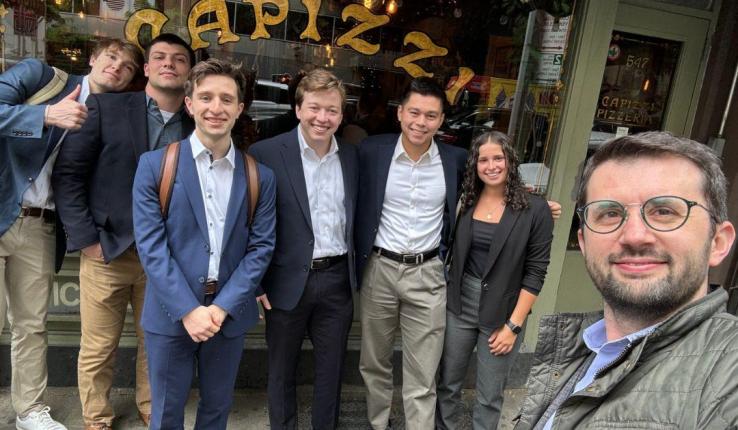On Getting Paid

At the third annual impact symposium of the College of Business and Economics, Morris Kleiner, professor of public affairs and the AFL-CIO chair at the University of Minnesota, addressed the impact of states’ occupational licensing.
Who has the right to decide how much someone gets paid?
Educators, community leaders and economists came together Friday (Sept. 30) at Lehigh to explore that provocative issue as the College of Business and Economics hosted its third annual impact symposium at the Rauch Business Center.
Titled Getting Paid: Earnings Issues in Today’s Economy, the daylong symposium allowed participants to delve into controversies—whether an increase in the minimum wage would lift people out of poverty as intended, whether the growth of occupational licensing is good for workers and the economy, whether the gender pay gap is real and whether soaring CEO compensation packages are justified.
“One of the most important things that we can do as a business school is just this,” said Dean Georgette Chapman Phillips, about the College bringing together thought leaders to discuss critical issues and share knowledge. “It’s important that we listen to the experts weigh in….There are few concerns that are more top-of-mind and pressing than earnings and wages.”
Among the morning speakers were William Wascher of the Federal Reserve System, who addressed the “Rhetoric and Reality” around minimum wage hikes; and Morris Kleiner, professor of public affairs and the AFL-CIO chair at the University of Minnesota, who presented “Our Guild-Ridden Labor Markets: The Curious Case of Occupational Licensing.”
Afternoon panels focused on gender wage inequality and CEO pay. A robust question-and-answer segment followed each presentation.
Wascher, deputy director in the Division of Research and Statistics at the Board of Governors, acknowledged that many Americans strongly support an increase in the minimum wage. (Proposals have called for increasing the federal minimum wage from $7.25 an hour to as much as $15, and states also have been taking steps to increase minimum wages.)
But Wascher questioned whether a minimum wage hike would have the intended result of lifting people out of poverty. He said there’s a preponderance of evidence that a wage hike would cost jobs and reduce employment opportunities, especially for the lowest skilled workers. Also, he said, many low-wage workers today are not in low-income families, as was the case in past decades and as many people might assume, but rather are likely suburban teenagers from middle- and high-income households.
So if a minimum wage hike is problematic, why is it so popular? Wascher posed. He said the American people genuinely want to help families that are less well-off and may be uncomfortable with income equalities, but they may misunderstand the potential impact of a minimum wage hike.
Research shows that the earned income tax credit, a refundable tax credit for low- to moderate-income working people, would be more effective in reducing poverty and encouraging work, he said.
'A Stealth Form of Regulation'
Also in the morning sessions, Kleiner addressed the impact of states’ occupational licensing, which, he said, raises the earnings of people who attain licensing by 10 to 18 percent but also makes it difficult for a person to enter a profession or work across states.
As union membership has decreased, he said, the number of licensed professionals has increased. Now, more than 800 occupations, including body piercers, florists, locksmiths and professional wrestlers, are licensed by at least one state.
“This has been a stealth form of regulation,” Kleiner said. While unions provided a web of rules at the workplace, mostly in the manufacturing industry, he said, “occupational licensing is establishing a web of rules in the service sector with the government establishing those regulations.”
And while union membership has reduced wage inequalities, he said, licensing either has had no effect or has increased wage inequalities, he said, because consumers likely have to pay more for services from licensed professionals.
Those who favor licensing argue that it helps shield the public from the incompetent or the irresponsible, Kleiner said, but others raise concerns that licensing limits innovation and experimentation. What’s important, he said, is to ensure that licensing maximizes public health and safety while minimizing the monopoly effects of the regulation.
He said policy proposals include prospective evaluations in which governments require a benefit-cost analysis prior to new occupational licensing requirements, retrospective evaluations in which governments develop a plan to evaluate existing occupational licensing requirements, and certification or other less limiting policies as a substitute for licensing.
Gender Wage Inequality
In the afternoon, Danielle Lindemann, associate professor of sociology at Lehigh, moderated the panel discussion on gender wage inequality. In her opening, she pointed to some of the reasons given for the pay gaps: occupational sex segregation, which means that women are choosing to enter careers and occupations that pay substantially less; the cultural and institutional mechanisms at play in occupational sorting; cultural differences in how men and women who advocate for themselves are viewed; women taking time off from their jobs for motherhood; and outright discrimination.
Panelists included Bryce Covert, economic policy editor at ThinkProgress; Paula England, Silver Professor of sociology at New York University, and Laurel Smith-Doerr, professor of sociology and director of the Institute for Social Science Research at the University of Massachusetts at Amherst.
All agreed that the gender pay gap is real and enduring, with working women earning about 80 cents for every dollar paid to men.
Covert, a journalist who writes about why the gender wage gap isn’t a myth, said that research shows that pay gaps occur in virtually every occupation tracked by the Bureau of Labor Statistics, even when women have the same major, grades and alma mater.
Occupational segregation is about both women’s choices and the jobs they do being undervalued, she said. Research shows that even when women move into jobs dominated by men, she said, pay drops for those positions.
“Because women are undervalued, when they go after higher-paying jobs they’re actually bringing the wages down,” Covert said.
Among the policy ideas that could help bridge the wage gap, she said, are a ban on salary secrecy so that employees can talk openly about what they earn; paid family leave and child care initiatives, and pay equity in which men and women are paid the same for similar work, such as housekeepers and janitors.
England said there are several types of discrimination, including in hiring and promotions. For one, she said, bias can creep in when employers are evaluating people’s performances. Also, in some subtle way, employers might think a job can’t be that important, and thus justifies lower pay, if mostly women are doing it. She said her research has shown that when an occupation becomes more feminized, the relative pay of that occupation goes down.
Smith-Doerr, an organizational theorist who studied wage differentials in federal science agencies such as the National Science Foundation, found that there were pay inequities between men and women, even when women were working in the same occupations and had the same qualifications.
“We have to think about this not just in terms of individual decisions but at the organizational level,” she said. “How do organizations make decisions about who is going to be paid what?”
The Impact of 'Say on Pay' for CEOs
A panel discussion on CEO pay rounded out the symposium. Panelists included Sydney Carlock, senior analyst on executive compensation at Institutional Shareholder Services; Donald F. Parsons, senior counsel at Morris, Nichols, Arsht & Tunnell in Delaware; and James F. Reda, managing director of executive compensation at Arthur J. Gallagher and Co.
Andrew Ward, associate dean for graduate programs at Lehigh and an organizer of the symposium, moderated the discussion.
“CEO pay is often in the headlines,” Ward said, “and these headlines often are written to draw outrage from the general public. CEOs in general have seen their pay escalate dramatically compared to the average worker.”
According to Economic Policy Institute, CEOs in the biggest American companies in 2015 earned 276 times the average annual pay of the typical worker. While that’s down since the 2008 financial crisis, it’s unclear whether the downward trend will continue of whether it’s a blip in the trend, he said.
A study by International Shareholder Services showed that the “Say on Pay” campaign, in which shareholders get to vote on CEOs' pay packages, has not resulted in lower CEO pay in the past five years but it has constrained the rate of growth in pay, Carlock said.
The median pay level for S&P 500 CEOs in 2011 was about $10.4 million, and in 2015, $10.5 million. So, considering that CEO compensation had previously been skyrocketing, she said, “that’s pretty good.”
More importantly, the composition of CEO pay has changed, with stronger tie-ins to performance, she said. Bonuses and long-term incentives are now based on objective performance goals over a multi-year period, stock options have fallen out of favor, and perks like country club memberships are disappearing, she said.
Photos by Christa Neu
Posted on:






